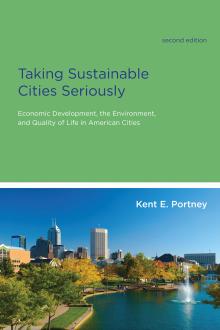BOOK REVIEW: Portney’s “Taking Sustainable Cities Seriously”

By Joan Hoffman
Are sustainable cities our salvation? The growth of city sustainability plans is impressive. Is this “greenwashing” or are the plans serious? Kent E. Portney, in Taking Sustainable Cities Seriously: Economic Development, the Environment, and Quality of Life in American Cities (2013; second edition, MIT Press), explores these questions using a “seriousness” index; each city’s seriousness score is the number of the 38 environmental, economic and administrative criteria that are included in in its sustainability plan. There are seriousness indices for 55 of the largest cities, and case studies for 5 large, 8 medium and 3 small cities. Portney provides context for this exploration by delving into the debates about sustainability in general and city sustainability in particular
Should cities be the focus for sustainability plans? Portney presents the critics complaints that cities are open systems which impose sustainability costs on others, are unwilling recipients of external pollutants and are subject to state and federal laws which can limit their actions. However, as Portney and other researchers observe, cities have important sustainability tools, such as zoning and building codes, and the U.S. lacks a federal program. The multi-scaled nature of sustainability problems is mentioned on both sides of the argument. While this means that cities cannot solve all of the problems, it also means that cities are necessarily part of the solution. It is fortunate that some have begun to act.
Does environmental sustainability require attention to social justice? Portney reports challenges to the traditional three pronged approach to sustainability which includes the environment, economy and society, based on the reasoning that they are inextricably interdependent. In particular, challengers argue that environmental sustainability can be obtained independently of social justice and that there are necessary trade-offs between the two goals. Portney’s own research indicates that social justice is generally included in sustainability plans by assumption rather than evidence. In practice, Portney found, many city plans ignore equity issues, and his index includes equity only implicitly (in two indicators). While the discussion ignores a literature supportive of equity as necessary for environmental sustainability, the frequent omission of equity from city plans is important information.
Why have so many cities embraced sustainability plans? According to Portney, recognition of problems created by traditional, unplanned private sector growth plays a role. Shrinkage of manufacturing has reduced resistance to anti-pollution polices, and cities have been responding to the lure of smart growth programs which channel growth to help shape compact, livable cities, attractive to “clean” investment and those with high level skills, often called the “creative class.” Sustainability programs often include smart growth components. Also, new money from the federal stimulus and energy programs helped initiate many sustainability plans.
Who should create sustainability indicators? Portney describes the debate about whether professionals with technical expertise or grass roots participatory activities should generate sustainability indicators. Environmental problems are complex, but top down plans from professionals without community participation can reportedly result in lack of community engagement. Perhaps the debate will result in artful combinations of both approaches.
Portney presents a related argument that community building is required in sustainability plans in order to overcome thre barriers to sustainability that require cooperation and cannot be solved by separate individuals acting in their own self interest. The problems include the commons (e.g. air pollution of the atmosphere), NIMBY (e.g. no hazardous waste in my backyard) and transboundary (e.g.shipping waste to neighbors). Portney offers examples of community engagement producing progress on these issues, but also notes that broader community participation can potentially increase conflict. Additionally, he reports that strong and deep community engagement is not a general characteristic of sustainability programs.
If not salvation, Portney does find indications of significant seriousness in many city sustainability plans using his index (with its weakness on equity issues). Surprisingly, the size of the city is not determinative of seriousness, but, interestingly, the size of the skilled or “creative class” does have an impact on the city scores. While evidence regarding plan implementation is only beginning to accumulate, Portney does discuss the issues in general and in case studies. This book offers a rich trove of information and analysis and is recommended reading for any serious student of sustainability.
 Joan Hoffman is an Economics Professor at John Jay College of Criminal Justice and the author of The Cooperation Challenge of Economics and the Protection of Water Supplies: A Case Study of the New York City Watershed Collaboration (2011). This is the first installment of a series entitled SEJ Book Reviews which will appear periodically on this blog.
Joan Hoffman is an Economics Professor at John Jay College of Criminal Justice and the author of The Cooperation Challenge of Economics and the Protection of Water Supplies: A Case Study of the New York City Watershed Collaboration (2011). This is the first installment of a series entitled SEJ Book Reviews which will appear periodically on this blog.